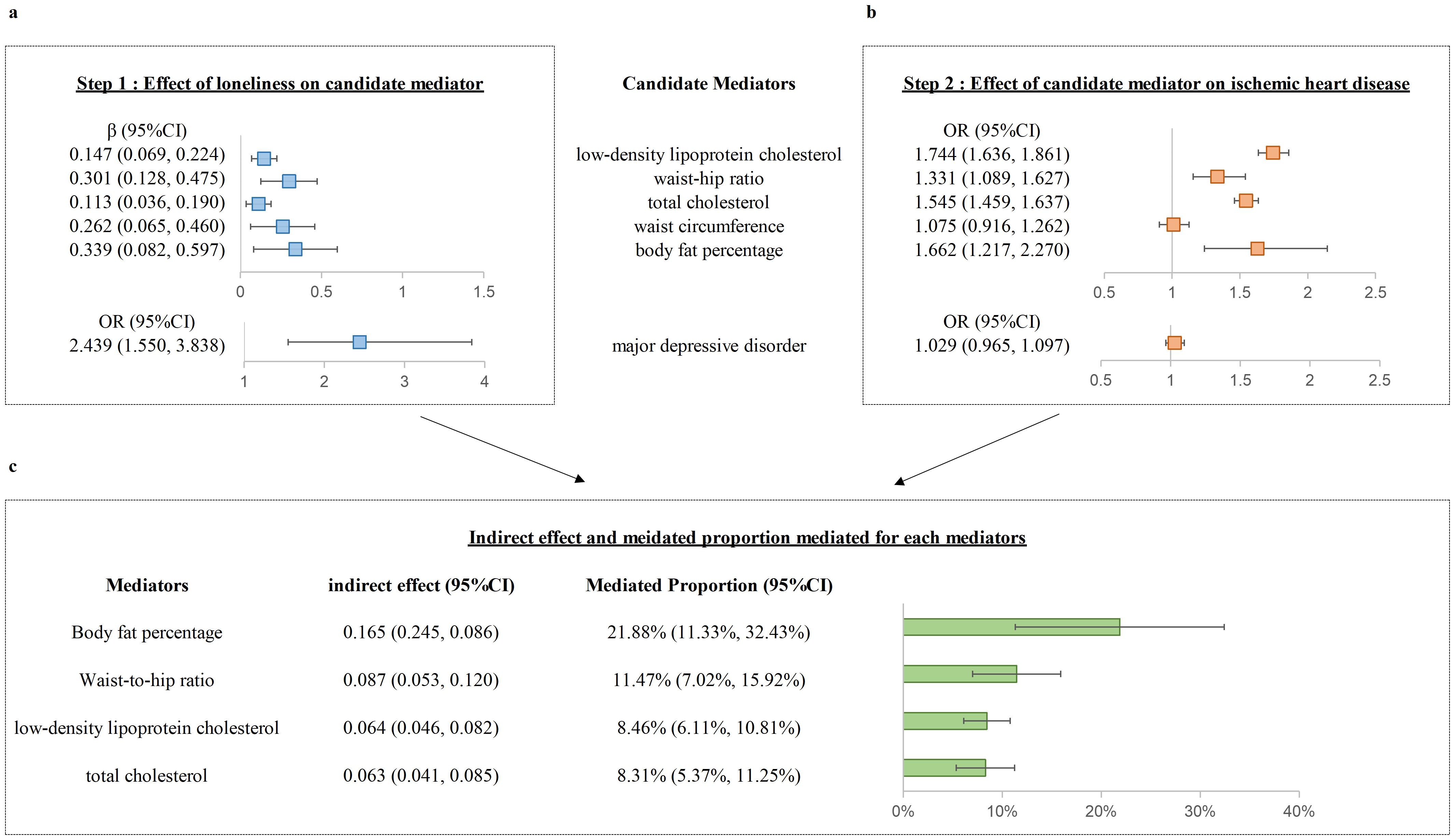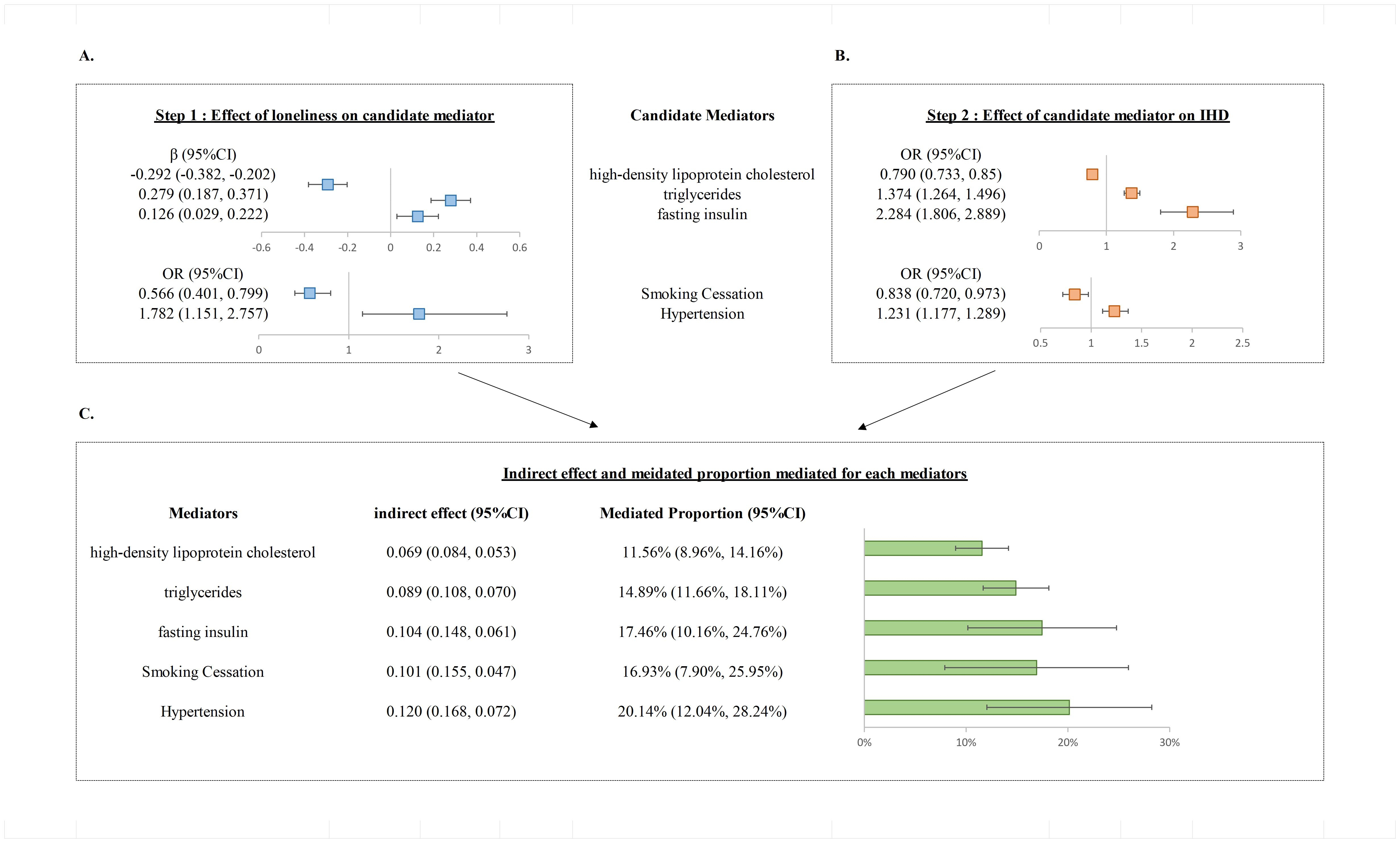Final ID: P3127
Loneliness and Social Isolation from Reduced Activities Increase Ischemic Heart Disease Risk via Metabolic and Behavioral Mediators: Evidence from Mendelian Randomization Study
Abstract Body: Introduction: Observational studies have linked loneliness or social isolation (SI) to ischemic heart disease (IHD), but results are inconsistent. Moreover, modifiable risk factors mediating the causal effects remain unclear.
Hypothesis: loneliness and SI causally increase IHD risk, with metabolic and behavioral factors acting as key mediators.
Methods: Using genetic instruments derived from summary-level Genome-Wide Association Studies data of European ancestry, we performed a bidirectional two-sample Mendelian Randomization (MR) study to estimate causal effects between loneliness (N=487,647) or SI and IHD (60,801 cases and 123,504 controls). SI traits included living alone (N=459,988), fewer social activities (N=459,830), and fewer contact with friends or family (N=461,369). Five subtypes of social activities were further analyzed, including sports club or gym, pub or social club, religious group, adult education class, or other group activities. Subsequently, a network MR study was conducted to evaluate the potential mediating effects of 20 candidate mediators and calculate their mediated proportions.
Results: Loneliness was causally associated with IHD (OR 2.129; 95% CI, 1.380 to 3.285), mediated by body fat percentage, waist-hip ratio, total cholesterol and LDL-C. Regarding SI traits, fewer social activities increased IHD risk (OR, 1.815; 95%CI, 1.189 to 2.772), and only sports club or gym had protected against IHD (OR, 0.333; 95%CI, 0.204 to 0.542). No evidence showed causality between living alone or contact frequency and IHD. Smoking cessation, HDL-C, triglycerides, hypertension and fasting insulin mediated the causal pathway from fewer social activities to IHD. Moreover, no evidence indicated the reverse causality of IHD with loneliness or SI. Results were robust in sensitivity analyses.
Conclusions: More attention should be paid to individuals who feel lonely or have fewer social activities for prevention of IHD, with several modifiable mediators as prioritized targets.
Hypothesis: loneliness and SI causally increase IHD risk, with metabolic and behavioral factors acting as key mediators.
Methods: Using genetic instruments derived from summary-level Genome-Wide Association Studies data of European ancestry, we performed a bidirectional two-sample Mendelian Randomization (MR) study to estimate causal effects between loneliness (N=487,647) or SI and IHD (60,801 cases and 123,504 controls). SI traits included living alone (N=459,988), fewer social activities (N=459,830), and fewer contact with friends or family (N=461,369). Five subtypes of social activities were further analyzed, including sports club or gym, pub or social club, religious group, adult education class, or other group activities. Subsequently, a network MR study was conducted to evaluate the potential mediating effects of 20 candidate mediators and calculate their mediated proportions.
Results: Loneliness was causally associated with IHD (OR 2.129; 95% CI, 1.380 to 3.285), mediated by body fat percentage, waist-hip ratio, total cholesterol and LDL-C. Regarding SI traits, fewer social activities increased IHD risk (OR, 1.815; 95%CI, 1.189 to 2.772), and only sports club or gym had protected against IHD (OR, 0.333; 95%CI, 0.204 to 0.542). No evidence showed causality between living alone or contact frequency and IHD. Smoking cessation, HDL-C, triglycerides, hypertension and fasting insulin mediated the causal pathway from fewer social activities to IHD. Moreover, no evidence indicated the reverse causality of IHD with loneliness or SI. Results were robust in sensitivity analyses.
Conclusions: More attention should be paid to individuals who feel lonely or have fewer social activities for prevention of IHD, with several modifiable mediators as prioritized targets.
More abstracts on this topic:
A Community-Based Intervention to Improve Cardiovascular Health Understanding in the Dallas-Fort Worth South Asian Community
Deo Parminder, Rohatgi Anand, Sharma Parul, Sathyamoorthy Mohanakrishnan
Sex differences in the effects of social isolation on behavioral and metabolic parameters in a model of cerebral amyloid angiopathyLiu Lillianne, Garg Shivi, Khan Romeesa, Jiang Danye, Mccullough Louise



